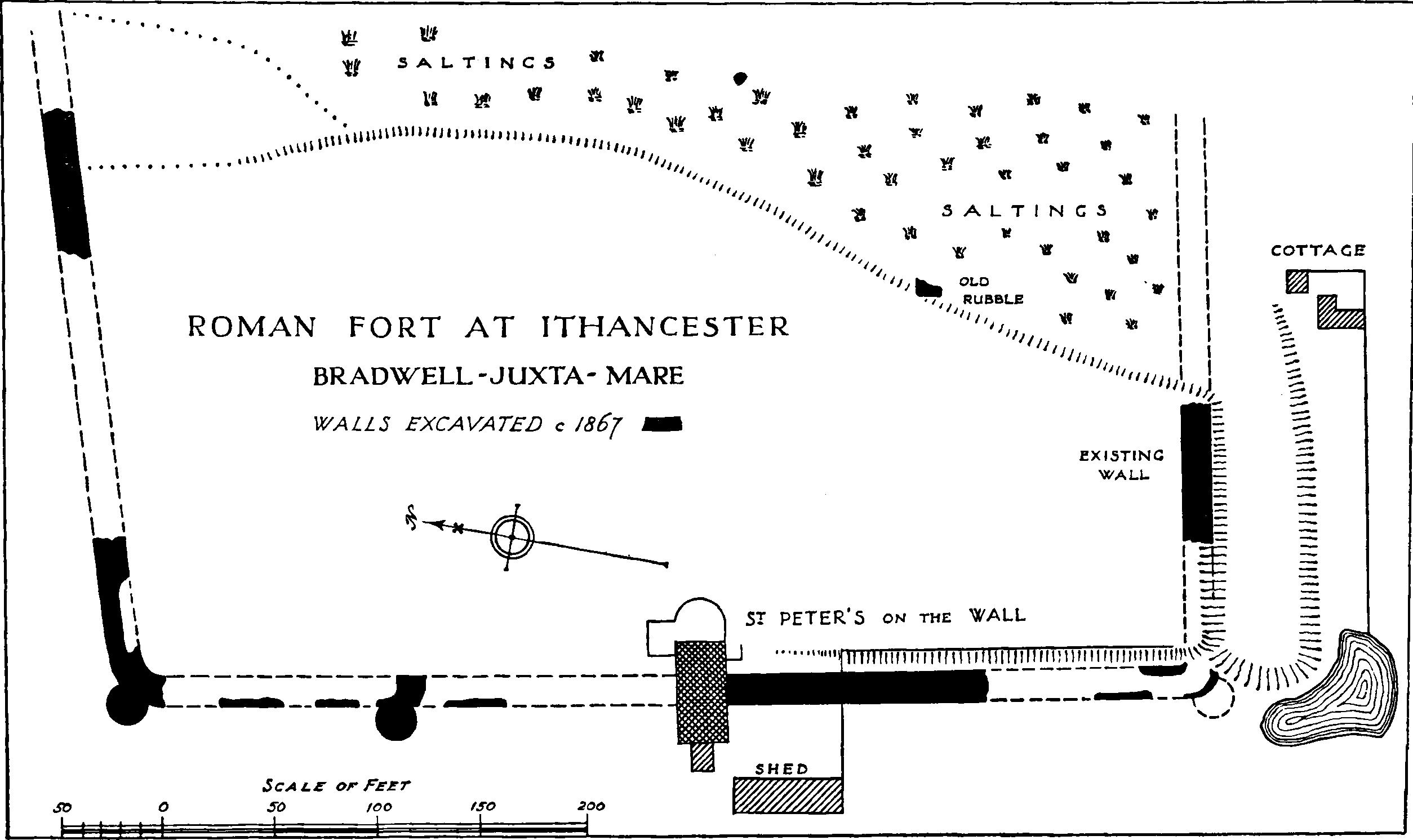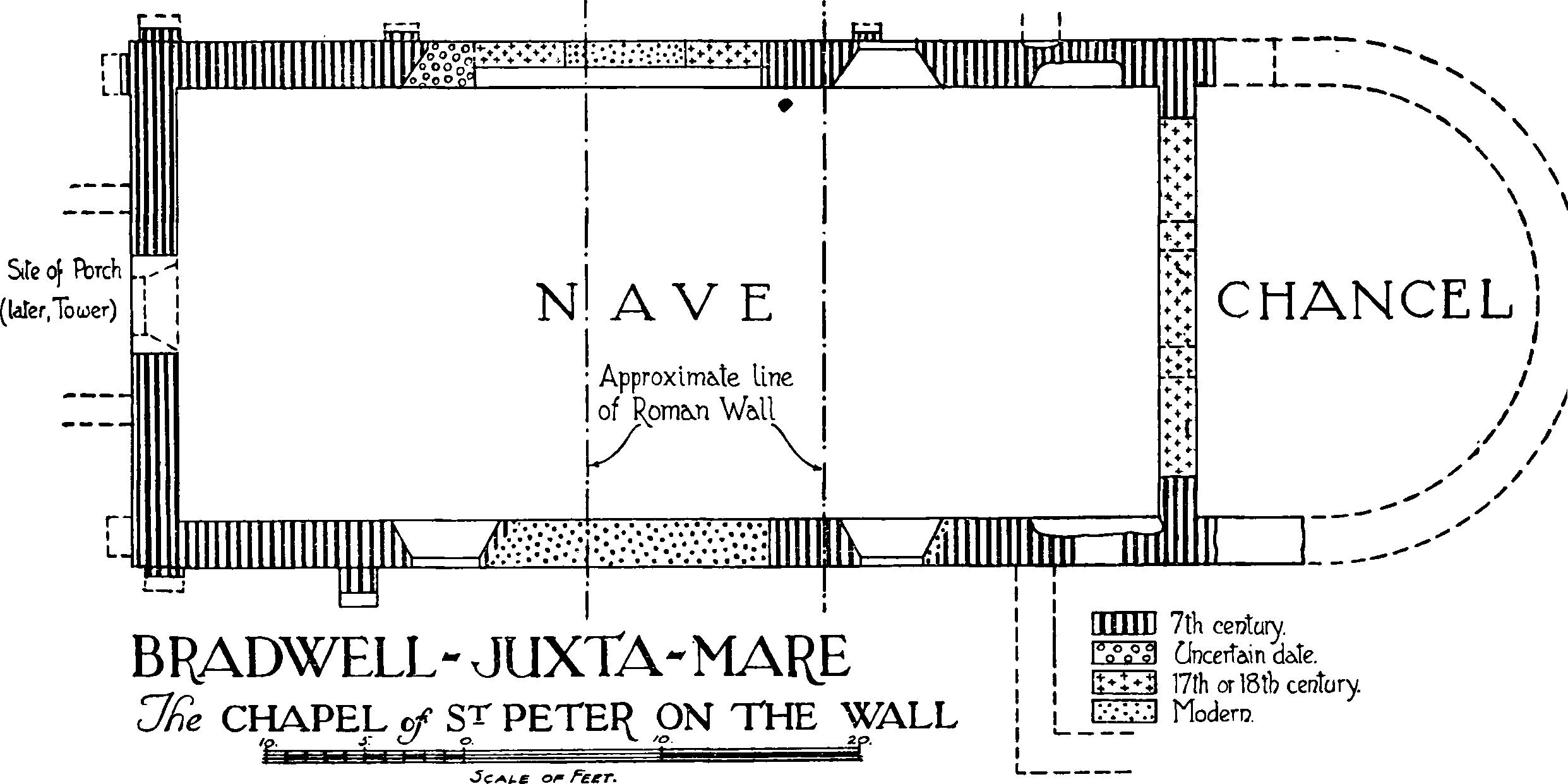Pages 13-16
An Inventory of the Historical Monuments in Essex, Volume 4, South east. Originally published by His Majesty's Stationery Office, London, 1923.
This free content was digitised by double rekeying and sponsored by English Heritage. All rights reserved.
In this section
8. BRADWELL-JUXTA-MARE. (G.a.)
(O.S. 6 in. (a)lv. N.E. (b)lv. S.E. (c)lvi. N.W.)
Bradwell-juxta-Mare is a parish 10 m. E. of Maldon. The remains of the Roman station of Othona and the chapel of St. Peter-on-the-Wall are the principal monuments.
Roman
c(1). Fort, probably Othona. The remains of a Roman fort, largely destroyed by the sea, are still partly visible 2 m. E.N.E. of the parish church. The plan, as revealed by excavation in 1864, shows the W. wall, 522 ft. long, and fragments of the N. and S. walls, 290 ft. and 150 ft. long respectively. The corners are rounded. At the N.W. corner is a horse-shce bastion, 16 ft. in diameter, and 115 ft. further S. is a similar bastion; a third was thought to have existed at the S.W. corner. The wall seems to have been about 12 ft. thick, and a fragment still existing on the S. side shows a triple layer of bricks (measuring 10–10¾ in. long by 1–1¾ in. thick), four courses of septaria (measuring 4½–6 in. by 3–3½ in.), surmounted by a second triple layer of bricks, with lavish use of mortar. The fragment (Plate, p. 13) stands to a height of 4 ft., and the interior of the fort is now level with the top of it. No gateways are known, but the line of the road approaching the site from the W. indicates the position of one approximately on the site of St. Peter's Chapel. Traces of a ditch have been observed on the W. and N. sides; on the S. side the line is marked by a wide ditch and by a pond at the S.W. corner. Traces of seaweed 5 ft. above the present high-water mark, apparently on the S. side, suggested to the excavators a Roman wharf, but without reason. Within the fort, the only structure noted was a short fragment of "old rubble-work" about 4 ft. high near the S. wall. No structural remains or burials are known outside the fort.

Roman Fort at Ithancester, Bradwell-Juxta-Mare
Many small objects were turned up during the excavations and are preserved by Mr. Christopher Parker at Faulkbourne Hall. Potsherds, coins and other small objects can be picked up on the surface. The coins date from Gallienus to Arcadius but are commonest for the Constantinian period. The pottery is mostly of the same date though a little appears to be of the second century as does also one brooch.
In character the fort resembles others of the series defending the 'Saxon Shore.' On the supposition that it was originally square, it would have contained rather more than 6 acres and so would have approximated in size, as in character, to the fort at Burgh in Suffolk. If its identification with the 'Othona' of the Notitia Dignitatum be accepted, it was garrisoned by irregular troops called Fortenses. (See Sectional Preface, p. xxxviii; and Arch., XLI, 440; Arch. Journ., XXII, 64, and XXIII, 60; C. R. Smith in Gent.'s Mag., 1865, II, 403–8; Coll. Antiq., VII, 155–6; Laver, Essex Arch. Soc., XI, 85; Raven, Ibid., VI, 291, 352. Further note by Chancellor in Arch. Journ., XXXIV, 212–3. C. R. Peers on the Chapel, Ibid., LVIII, 420, with plan.)
Ecclesiastical
a(2). Parish Church of St. Thomas stands in the village. The walls of the chancel are of flint and septaria-rubble, those of the nave are of brick and stone and the tower is of brick; the dressings are of limestone; the roofs are tiled. The Chancel was built probably early in the 14th century. The Nave was re-built in 1706 and the West Tower added. The church has been restored in modern times, the N. Organ Chamber added and the chancel partly re-built.

The Church, Plan
Architectural Description— The Chancel (37½ ft. by 19 ft.) has a modern E. window. In the N. wall is a window all modern except the splays; further W. is a modern archway. In the S. wall are two windows uniform with that in the N. wall. The early 14th-century chancel-arch is two-centred and of two moulded orders; the responds have each three attached shafts with moulded capitals.
The Nave (65¼ ft. by 25 ft.) is of c. 1706 except the E. gable, which is partly of early 16th-century brick with trefoiled corbelling; all the windows and the doorway are modern.
The West Tower (10¼ft. square) is of red brick and of three stages with an embattled parapet. It is entirely of c. 1706. In the E. wall is a modern doorway. The N. and S. walls have each a window with a rounded head, wooden frame, mullion and transom. In the S. wall is a doorway with a segmental head. The W. doorway is modern. The second stage has windows in the N. and S. walls, and the bell-chamber a window in each wall, all similar to those in the ground-stage.
Fittings—Brasses and Indents. Brasses: In chancel—on N. wall, (1) of Margaret Wyott, 1526, figure of woman in pedimental head-dress, etc.; (2) shield-of-arms—three owls and a sinister quarter impaling four bars on a bend three scallops, early 16th-century; (3) to John Debanke, rector, 1601, inscription only; (4) to Thomas Debanck, 1606, inscription only. Indents: In nave—(1) and (2) of inscription-plates; (3) of two figures, two groups of children, inscription-plate and shield; (4) of figure, inscription-plate and shield. Chair: In chancel—with turned legs and carved back, early 18th-century. Font (Plate, pp.xlii-iii): octagonal bowl with moulded under-edge and four large heads, one of a priest and one with a bandeau, projecting from alternate faces and formerly with a shaft beneath each, round stem, 14th-century. Monuments: In chancel—in N. wall, (1) two stone panels, from former monument, with cusped heads and shields— (a) a cheveron engrailed between three roundels each charged with a cross, a crescent for difference, (b) a cheveron between three scallops, early 16th-century; on S. wall, (2) to John Sherman, S.T.P. Rector of the parish, 1666, alabaster and black marble tablet with side pilasters and shield-of-arms. Plate: includes cup of 1626, dated 1626, and an early 18th-century pewter flagon and plate. Scratching: On S. wall of nave—date 1707. Miscellanea: Incorporated in walls of nave— many worked stones and 14th-century head-stops.
Condition—Good, but tower overgrown with ivy.
c(3). Chapel of St. Peter-on-the-Wall stands nearly 2 m. E.N.E. of the parish church. The walls are almost entirely of re-used Roman material including ashlar, septaria and brick; the roof is tiled. The chapel is almost certainly that built by Bishop Cedd in c. 654 at Ithancester. It stands astride the former W. wall of the Roman station and originally consisted of an apse, Nave and W. porch and possibly 'porticus' on the N. and S. A tower was subsequently added above the porch. It was a chapel-of-ease to Bradwell in the Middle Ages, but was eventually desecrated and used as a barn; the apse and tower were destroyed. It has recently been restored and is now again used as a chapel (Plates, pp. 16,17).
The building is of extreme interest as one of the earliest surviving churches in England.
Architectural Description— The Apse has been destroyed to the foundations but the plan has been recovered by excavation; it projected about 17 ft. to the E. of the present E. wall and the side walls rose to a height of 21 ft. The stump of the N. wall retains the W. jamb of a former doorway.
The Nave (49½ ft. by 21½ ft.) has walls 2½ ft. thick and rising to a height of 24 ft. under the eaves. In the E. wall are the Roman brick springers and responds of two arches about 2 ft. within the side walls, the rest of the wall is comparatively modern and built of re-used material. The arrangement indicated is that of the usual three arches as at St. Pancras, Canterbury, Reculver, etc., but the existing remains of the curves of the two side arches hardly allow of a central arch of the same span. The N. and S. walls were apparently divided into bays by tabled buttresses and there were pairs of similar buttresses at the western corners leaving the angles of the building free. In the middle of the N. and S. walls is a large modern section showing the position of the entrances when the building was used as a barn. At the E. end of the S. wall are remains of an original doorway, perhaps opening into a 'porticus' and further W. are the foundations of an added wall. The four windows, two on each side, have original jambs and splays and modern lintels replacing original lintels; they have been much altered; the N.W. window is blocked and partly destroyed and all are set high in the wall. In the W. wall is an original doorway with a modern lintel; above it is an original window with a round head of Roman brick and jambs partly of brick and partly of stone. Flanking the doorway are traces of the junction of the walls of the former porch. Foundations of this porch have been discovered and also those of an annexe on the S. side of the nave.

Bradwell-Juxta-Mare, the Chapel of St Peter on the Wall
Condition—Good.
Secular
c(4). Rectory, S. of the church, is of two storeys, timber-framed and plastered; the roofs are tiled. The N. wing is of early 16th-century date; it was extended S. at some uncertain date and c. 1780 a large S. wing in the Adam style was built. Inside the building one room of the old wing has original moulded ceiling-beams and joists; the room at the N. end of the same wing has an open-timbered ceiling.
Condition—Good.
c(5). Munkin's Farm, house, ¾ m. S.W. of (3), is of two storeys, timber-framed and weather-boarded; the roofs are tiled. It was built in the 15th or 16th century with cross-wings at the E. and W. ends. Inside the building are some exposed ceiling-beams and one room is lined with early 18th-century panelling.
Condition—Fairly good.
b(6). Bradwell Hall, 1¼ m. S.W. of the parish church, is of two storeys, timber-framed and plastered; the roofs are tiled. It was built early in the 17th century and has a cross-wing at the E. end. The original central chimney-stack has the bases of four grouped diagonal shafts.
Condition—Good.
a(7). Cage and Whipping Posts, at S. E. corner of churchyard. The cage is an 18th-century structure of brick and built into it are the oak whipping posts.


